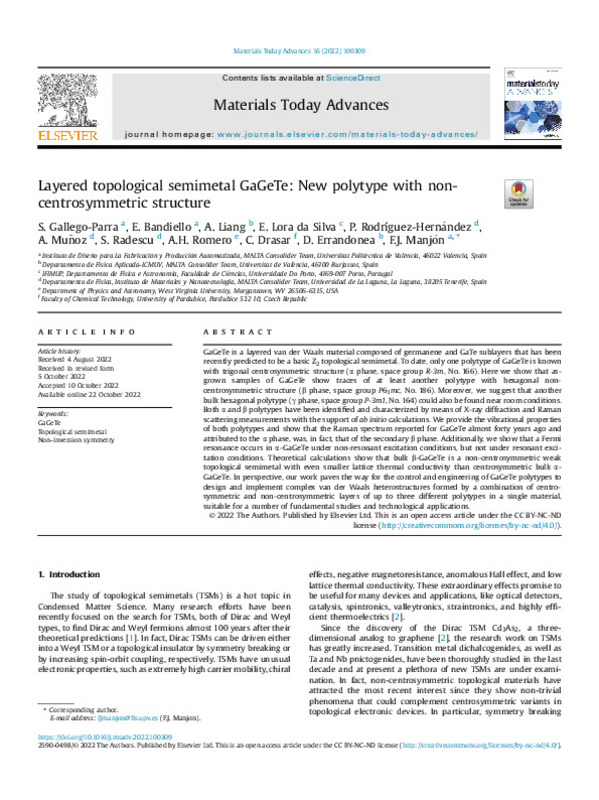|
Resumen:
|
[EN]
GaGeTe is a layered van der Waals material composed of germanene and GaTe sublayers that has been recently predicted to be a basic Z2 topological semimetal. To date, only one polytype of GaGeTe is known with trigonal ...[+]
[EN]
GaGeTe is a layered van der Waals material composed of germanene and GaTe sublayers that has been recently predicted to be a basic Z2 topological semimetal. To date, only one polytype of GaGeTe is known with trigonal centrosymmetric structure (a phase, space group R-3m, No. 166). Here we show that asgrown samples of GaGeTe show traces of at least another polytype with hexagonal noncentrosymmetric structure (f3 phase, space group P63mc, No. 186). Moreover, we suggest that another bulk hexagonal polytype (g phase, space group P-3m1, No. 164) could also be found near room conditions. Both a and f3 polytypes have been identified and characterized by means of X-ray diffraction and Raman scattering measurements with the support of ab initio calculations. We provide the vibrational properties of both polytypes and show that the Raman spectrum reported for GaGeTe almost forty years ago and attributed to the a phase, was, in fact, that of the secondary f3 phase. Additionally, we show that a Fermi resonance occurs in a-GaGeTe under non-resonant excitation conditions, but not under resonant excitation conditions. Theoretical calculations show that bulk f3-GaGeTe is a non-centrosymmetric weak topological semimetal with even smaller lattice thermal conductivity than centrosymmetric bulk aGaGeTe. In perspective, our work paves the way for the control and engineering of GaGeTe polytypes to design and implement complex van der Waals heterostructures formed by a combination of centrosymmetric and non-centrosymmetric layers of up to three different polytypes in a single material, suitable for a number of fundamental studies and technological applications.
[-]
|
|
Agradecimientos:
|
This publication is part of the project MALTA Consolider Team network (RED2018-102612-T) , financed by MINECO/AEI/10.13039/501100003329; by I ? D ? i projects PID2019-106383 GB -41/42/43 financed by MCIN/AEI/10.13039/501100011033; ...[+]
This publication is part of the project MALTA Consolider Team network (RED2018-102612-T) , financed by MINECO/AEI/10.13039/501100003329; by I ? D ? i projects PID2019-106383 GB -41/42/43 financed by MCIN/AEI/10.13039/501100011033; and by project PROMETEO/2018/123 (EFIMAT) financed by Generalitat Valenciana. E.B. would like to thank the Universitat Politecnica de Valencia for his postdoctoral contract (Ref. PAID -10-21) . AHR was supported by the U.S. Department of Energy (DOE) , Office of Science, Basic Energy Sciences under award DE-SC0021375. We also acknowledge the computational resources awarded by XSEDE, a project supported by National Science Foundation grant number ACI-1053575. The authors also acknowledge the support from the Texas Advances Computer Center (with the Stampede2 and Bridges supercom- puters) . E.L.d.S would like to acknowledge the Network of Extreme Conditions Laboratories (NECL) , financed by FCT and co -financed by NORTE 2020, through the program Portugal 2020 and FEDER; the High Performance Computing Chair-a R & D infrastructure (based at the University of ? Evora; PI: M. Avillez) ; and for the computational support provided by the HPC center OBLIVION -U. ? Evora to perform the lattice thermal conductivity calculations. A.L. and D.E. would like to thank the Generalitat Valenciana for the Ph.D. Fellowship no. GRISOLIAP/2019/025.
[-]
|









